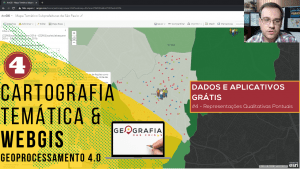Geodesign for Campus University Planning and Governance

Geodesign South America 2017 – Strategic Planning for Alternative Futures
Belo Horizonte, Brazil, December 11-14, 2017
Escola de Arquitetura da UFMG
CEREDA JUNIOR, A.; FRANÇOSO, M.T. Geodesign for Campus University Planning and Governance. Anais… Geodesign South America 2017: Strategic Planning for Alternative Futures. Belo Horizonte: UFMG. 2017.
Introduction
Usage of technical analyses and comprehension, paired with intervention of the geographical space permeates human history: Geographical Intelligence is ingrained through the civilization process, this usage “provides field specialists control over the decision-making process”, also the “use of the geo-space possibilities to provide answers to one or more issues, be them social, financial or from nature”. Its left to the people and organizations which control territorial governance, private sector and other entities to technically take ownership of a platform that will deliver geographical informational analyses – GIS.
Currently there are structural changes to Geographic Information Systems (GIS), with a fully integrated view over “System of Records” (mostly explored in heritage concepts), with adoption of “Systems of Engagement” and “Systems of Knowledgement”. Society interacts ubiquitous and transparently with Devices, Living Experience, Systems of Information and Society who are integrated by information networks, as predicted by Castells (2003), who observed that relationships aren’t restricted to man-machine only, but are meant to bridge citizen-society-technology.
Planning and governance over territory and landscape is under a technical, methodical, collaborative transformation, including a “University Campus”, a territorial unit left behind when discussing ‘planning’ from governance support, physical infrastructure maintenance – that accounts for property and people security, creating scenarios for analyses, such as the physical layout, room occupation count, taking in factors such as demand for new infrastructure, revealing the need for geo tools that further help understand the complex nature of the real world, commonly structured in layers.
Flourishing non-technical usage of geo information systems, structured over solid methods, takin up opportunities to advance the “inventory / register” model, proper handle of information to generate knowledge – allowing Geographical Intelligence with an integrated holistic thought – from the initial data collecting field work, besides cartography products, remote sensors and others – all with the purpose to propose actual intervention in the world.
Geodesign and Geographical Intelligence
Geographic Information Systems provide further capabilities than common usage of maps and infographics to support the decision-making process; advancement in physical and land use planning and management that incorporates practices such as storing and collecting data from previously established models, enabling answers to specific questions leading to custom solutions, revealing new readings from the physical space form, providing ability to identify under laying questions and integrated solutions. This way with the advancement of a structured methodology, support and solutions are found within geodesign.
A concept that might sound new to Brazilian literature and science, being used for approximately 30 years by Carl Steinitz (1995, 2012), used design process to perform geo analysis by asking a set of questions and utilizing methods to resolve big problems, significantly complex projects with varying scales, such as an entire neighborhoods, a region or a hydrographic basin (STEINITZ, 2012) – or as presented for this current paper, a University Campus.
For Goodchild (2010) while Geography is a set of procedures that operate above or near Earth, geodesign refers to object intervention based on this output, aiming to integrate anthropic activities with the natural environment, respecting cultural peculiarities empowering a democratic decision making process.
Geodesign appropriation for university campuses planning and governance
Considering a methodological proposal, Steinitz (2012) established six models to answer questions that organized this analytical process, three of them focused on the evaluation of field study and the later three on intervention seeking aspects of result and purpose. The proposed interventional research currently developed at Universidade Estadual de Campinas (UNICAMP-SP) would be structured based on these same processes, usage of Representation Models, Procedure and Evaluation, proposing five key dimensions:
- Business Strategy and Information Technology, with the objective to understand overall business strategy for campus university governance; ii. Business Process Comprehension, for existing plans be them short-term or long-term, fulfilling challenges that are the institutions priority; iii. Application Functionality, knowledge of the existing systems and business procedures involved for current and under development solutions; iv. Application Architecture, deepened knowledge of systems and processes involved on current and under development solutions and v. Business Intelligence, analytical comprehension of captured data, tied to the decision-making process – along with the proposal of new key indicators.
Final Considerations
This current paper showcases research results that help develop analytical study and development based concepts of the Geodesign paradigm as described by STEINITZ (1995, 2012), considering space-living dimensions, collaboration and community engagement, multi-scale modeling, setting of parameters for 3D space-time analyses, seeking efficient levels of governance planning for university campuses or any other unit of land management with comparable scale and dimension.
Management and the maintenance of physical infrastructure, furthering a descriptive portrayal of the physical land for university campuses, map generation, apps and dashboards, that optimize resource utilization are made possible by pillaring Geodesign as a campus wide administrative governance.
Road mapping knowledge for integrated policy applied on its own physical administrative dimension with Geodesign, would have wide positive results on all aspects along the distinct levels of implementation, reaching achievable goals.
Bibliography
CASTELLS, M. A sociedade em rede. São Paulo: Paz e Terra, 2003.
GOODCHILD, M. F. Towards Geodesign: Repurposing Cartography and GIS? Cartographic Perspectives, 66, 7-21. 2010.
STEINITZ, C. A Framework for Geodesign: changing Geography by Design. Redlands: Esri Press, 2012.
STEINITZ, C. A Framework for Landscape Planning Practice and Education. Process Architecture, no. 127, 1995.





Sobre o autor